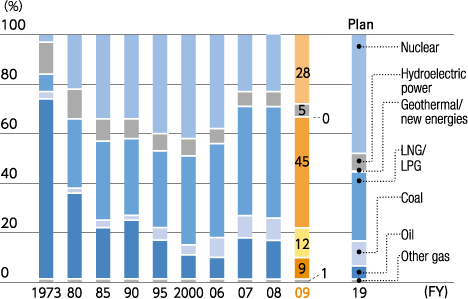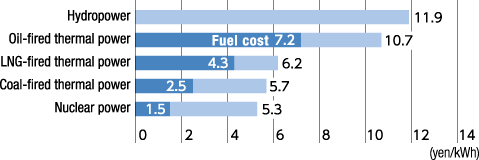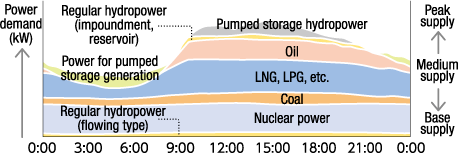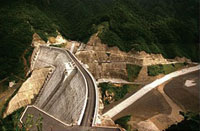Each energy resource and power generation method has its own balance of "stability," "environmental performance," and "economic efficiency." TEPCO maximizes and combines the strengths of each to suit medium- to long-term energy situations. Through the use of this "best mix" of power sources, we hope to continue delivering a stable supply of high-quality electricity at low cost.
Japan has few energy resources of its own, but having learned an important lesson from the two oil crises in the 1970s, it is now promoting the development and introduction of alternative power sources such as nuclear power, LNG, and coal, with the aim of diversifying power generation sources.
TEPCO is creating a well-balanced power generation environment that maximizes the respective advantages of different types of power generation methods, including nuclear power, thermal power, and hydropower generation, from the comprehensive perspective of stable supply, environmental performance, and economic efficiency. This combination of different types of power sources is commonly referred to as "the best mix of power sources." We will make ongoing efforts to develop nuclear power, introduce thermal power generation systems that boast the world's highest efficiency level, and expand the use of renewable energy, so that we may continue to deliver stable, low-cost electricity supplies to our customers and contribute to creating a low-carbon society.
TEPCO energy output by energy source (including purchased power)

Nuclear power generation is an outstanding power generation method in terms of stability, environmental performance, and economic efficiency, and supplies roughly 30% of all power generated by TEPCO.
Long-term energy security is a critical issue to Japan, as it has few energy resources of its own compared to other major countries in the world.
Nuclear power plays an important role in Japan's energy strategies as a key power source, for several reasons: uranium, the fuel for nuclear power generation, is imported from politically stable countries such as Australia and Canada; once uranium is loaded in the nuclear reactor, it can generate power for a whole year, at the least, without replacement; and it is recyclable.
Amount of fuel required to operate a 1,000 MW power plant for a year
 Source: Agency for Natural Resources and Energy, "Nuclear Power 2009
Source: Agency for Natural Resources and Energy, "Nuclear Power 2009
Nuclear power generation is also environment-friendly. Because it uses the heat that is given off by uranium during nuclear fission, it releases no CO2, the primary cause of global warming, nor NOx and SOx, the major sources of air pollution, in the process of generating power.
Nuclear power generation contributes to maintaining stable electricity rates, despite the recent volatility in the prices of crude oil and other fossil fuels. This is because the cost of fuel is such a small part of the total cost of nuclear power generation that changes in fuel prices have little impact on power generation cost.
Power generation cost per 1 kWh of power, by source
 (Note)Figures for nuclear power, thermal power, and hydropower are based on a service life of 40 years and a utilization rate of 80% (45% in the case of hydropower).
(Note)Figures for nuclear power, thermal power, and hydropower are based on a service life of 40 years and a utilization rate of 80% (45% in the case of hydropower).
Sources: Nuclear power, thermal power, hydropower -Working Group on Costs, etc., Electric Power Subcommittee, Advisory Committee for Natural Resources and Energy (Jan. 2004)
Thermal power is capable of responding flexibly to rapid changes in demand for power, and accounts for roughly 60% of all power generated by TEPCO.
From the perspective of energy security, TEPCO promotes diverse uses of fossil energies, as well as implements ongoing measures to increase energy efficiency, in the effort to ensure effective utilization of energy resources and reduce CO2 emissions.
Electricity use varies according to season, temperature, and time of day. Temperature has a particularly large influence on power demand during the summer, when a 1℃ rise in temperature significantly increases demand for air conditioning. TEPCO's maximum power supply increases by almost 1,700 MW during this period.
Electricity cannot be stored, and must be used as it is produced. Therefore, thermal power generation, by virtue of its ability to respond flexibly to ever-changing power demand, plays a central role in delivering stable supply of electricity.
Power demand and generation during a day

TEPCO's power plants utilize a wide range of fuels from the perspective of fuel stability, environmental performance, and economic efficiency. They include LNG (liquefied natural gas) and LPG (liquefied petroleum gas), which are clean, sulphur-free energy sources; coal, which are available in abundance around the world; and oil, which serves as an excellent buffer to fuel supplies.
TEPCO's thermal power plants boast the world's highest thermal efficiency levels.
1% increase in the thermal efficiency of these power plants would reduce CO2 emissions by about 1.9 million tons/year and save 800,000 kR/year of fuel (heavy oil equivalent). Based on an awareness of these benefits, we will continue to introduce high-efficiency power generation facilities and otherwise aim to further increase thermal power generation efficiency.
Hydropower generation is an important source of energy to Japan, because although Japan has few energy resources of its own, this generation system only requires resources that are available in Japan. It is also noted for its excellent environmental performance, because it releases no CO2 in the power generation process.
Moreover, the unique characteristic of being able to achieve maximum output in just a short time after start of operations makes hydropower generation indispensable to ensuring stable power supply.
Hydropower generation achieves maximum output in just a few minutes of the start of operations of the generator, and can change output volumes in a matter of a few seconds by regulating the flow of water. This outstanding readiness is extremely helpful in responding to demands during peak times, when power demand fluctuates most drastically during a single day.


Kannagawa Power Station: www.tepco.co.jp/gunma/kanna-gawa/10_0-j.html
Hydropower generation contributes to maintaining Japan's energy self-sufficiency even though Japan is a country poor in resources, because it uses only domestically procurable renewable energy sources. It also provides excellent power supply stability and environmental performance, as it does not release CO2 or other greenhouse gases in the power generation process.
Understanding the benefits of hydropower generation, TEPCO is making ongoing efforts to improve hydropower generation efficiency by rehabilitating aging facilities in existing power plants and developing new water turbine technologies.
Power generation using renewable energy sources such as wind and sunlight is important to Japan, because it uses only domestically procurable energy sources. It is also garnering attention as a promising countermeasure to global warming, because it releases no CO2 or other greenhouse gases in the power generation process. Although output is easily affected by changes in natural environmental conditions, we are focusing on the advantages of renewable energy and are actively promoting its development and introduction while also considering its economic performance.
© Tokyo Electric Power Company Holdings, Inc.